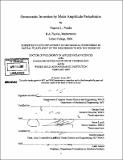| dc.contributor.advisor | George Frisk and James Lynch. | en_US |
| dc.contributor.author | Poole, Travis L | en_US |
| dc.contributor.other | Woods Hole Oceanographic Institution. | en_US |
| dc.date.accessioned | 2007-09-28T13:12:48Z | |
| dc.date.available | 2007-09-28T13:12:48Z | |
| dc.date.copyright | 2007 | en_US |
| dc.date.issued | 2007 | en_US |
| dc.identifier.uri | http://hdl.handle.net/1721.1/38932 | |
| dc.description | Thesis (Ph. D.)--Joint Program in Applied Ocean Physics and Engineering (Massachusetts Institute of Technology, Dept. of Mechanical Engineering; and the Woods Hole Oceanographic Institution), 2007. | en_US |
| dc.description | Includes bibliographical references (p. 124-126). | en_US |
| dc.description.abstract | This thesis introduces an algorithm for inverting for the geoacoustic properties of the seafloor in shallow water. The input data required by the algorithm are estimates of the amplitudes of the normal modes excited by a low-frequency pure-tone sound source, and estimates of the water column sound speed profiles at the source and receiver positions. The algorithm makes use of perturbation results, and computes the small correction to an estimated background profile that is necessary to reproduce the measured mode amplitudes. Range-dependent waveguide properties can be inverted for so long as they vary slowly enough in range that the adiabatic approximation is valid. The thesis also presents an estimator which can be used to obtain the input data for the inversion algorithm from pressure measurements made on a vertical line array (VLA). The estimator is an Extended Kalman Filter (EKF), which treats the mode amplitudes and eigenvalues as state variables. Numerous synthetic and real-data examples of both the inversion algorithm and the EKF estimator are provided. The inversion algorithm is similar to eigenvalue perturbation methods, and the thesis also presents a combination mode amplitude/eigenvalue inversion algorithm, which combines the advantages of the two techniques. | en_US |
| dc.description.statementofresponsibility | by Travis L. Poole. | en_US |
| dc.format.extent | 126 p. | en_US |
| dc.language.iso | eng | en_US |
| dc.publisher | Massachusetts Institute of Technology | en_US |
| dc.rights | M.I.T. theses are protected by copyright. They may be viewed from this source for any purpose, but reproduction or distribution in any format is prohibited without written permission. See provided URL for inquiries about permission. | en_US |
| dc.rights.uri | http://dspace.mit.edu/handle/1721.1/7582 | |
| dc.subject | Joint Program in Applied Ocean Physics and Engineering. | en_US |
| dc.subject | Mechanical Engineering. | en_US |
| dc.subject | Woods Hole Oceanographic Institution. | en_US |
| dc.subject.lcsh | Underwater acoustics | en_US |
| dc.subject.lcsh | Ocean-atmosphere interaction | en_US |
| dc.title | Geoacoustic inversion by mode amplitude perturbation | en_US |
| dc.type | Thesis | en_US |
| dc.description.degree | Ph.D. | en_US |
| dc.contributor.department | Joint Program in Applied Ocean Physics and Engineering | en_US |
| dc.contributor.department | Woods Hole Oceanographic Institution | en_US |
| dc.contributor.department | Massachusetts Institute of Technology. Department of Mechanical Engineering | |
| dc.identifier.oclc | 166142418 | en_US |
